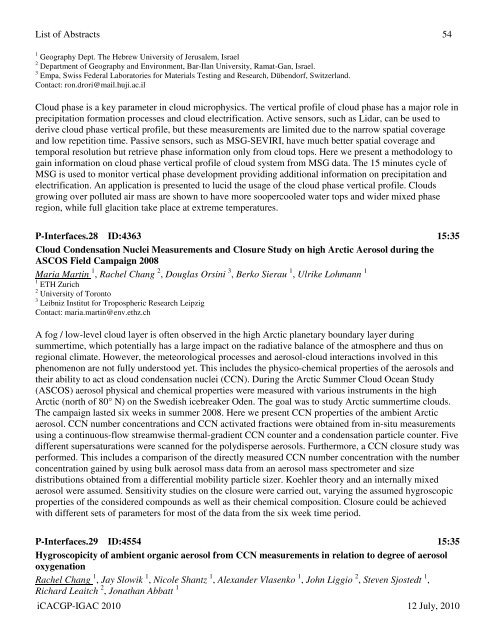Download Abstracts Here - IGAC Project
Download Abstracts Here - IGAC Project
Download Abstracts Here - IGAC Project
Create successful ePaper yourself
Turn your PDF publications into a flip-book with our unique Google optimized e-Paper software.
List of <strong>Abstracts</strong> 541 Geography Dept. The Hebrew University of Jerusalem, Israel2 Department of Geography and Environment, Bar-Ilan University, Ramat-Gan, Israel.3 Empa, Swiss Federal Laboratories for Materials Testing and Research, Dübendorf, Switzerland.Contact: ron.drori@mail.huji.ac.ilCloud phase is a key parameter in cloud microphysics. The vertical profile of cloud phase has a major role inprecipitation formation processes and cloud electrification. Active sensors, such as Lidar, can be used toderive cloud phase vertical profile, but these measurements are limited due to the narrow spatial coverageand low repetition time. Passive sensors, such as MSG-SEVIRI, have much better spatial coverage andtemporal resolution but retrieve phase information only from cloud tops. <strong>Here</strong> we present a methodology togain information on cloud phase vertical profile of cloud system from MSG data. The 15 minutes cycle ofMSG is used to monitor vertical phase development providing additional information on precipitation andelectrification. An application is presented to lucid the usage of the cloud phase vertical profile. Cloudsgrowing over polluted air mass are shown to have more soopercooled water tops and wider mixed phaseregion, while full glacition take place at extreme temperatures.P-Interfaces.28 ID:4363 15:35Cloud Condensation Nuclei Measurements and Closure Study on high Arctic Aerosol during theASCOS Field Campaign 2008Maria Martin 1 , Rachel Chang 2 , Douglas Orsini 3 , Berko Sierau 1 , Ulrike Lohmann 11 ETH Zurich2 University of Toronto3 Leibniz Institut for Tropospheric Research LeipzigContact: maria.martin@env.ethz.chA fog / low-level cloud layer is often observed in the high Arctic planetary boundary layer duringsummertime, which potentially has a large impact on the radiative balance of the atmosphere and thus onregional climate. However, the meteorological processes and aerosol-cloud interactions involved in thisphenomenon are not fully understood yet. This includes the physico-chemical properties of the aerosols andtheir ability to act as cloud condensation nuclei (CCN). During the Arctic Summer Cloud Ocean Study(ASCOS) aerosol physical and chemical properties were measured with various instruments in the highArctic (north of 80° N) on the Swedish icebreaker Oden. The goal was to study Arctic summertime clouds.The campaign lasted six weeks in summer 2008. <strong>Here</strong> we present CCN properties of the ambient Arcticaerosol. CCN number concentrations and CCN activated fractions were obtained from in-situ measurementsusing a continuous-flow streamwise thermal-gradient CCN counter and a condensation particle counter. Fivedifferent supersaturations were scanned for the polydisperse aerosols. Furthermore, a CCN closure study wasperformed. This includes a comparison of the directly measured CCN number concentration with the numberconcentration gained by using bulk aerosol mass data from an aerosol mass spectrometer and sizedistributions obtained from a differential mobility particle sizer. Koehler theory and an internally mixedaerosol were assumed. Sensitivity studies on the closure were carried out, varying the assumed hygroscopicproperties of the considered compounds as well as their chemical composition. Closure could be achievedwith different sets of parameters for most of the data from the six week time period.P-Interfaces.29 ID:4554 15:35Hygroscopicity of ambient organic aerosol from CCN measurements in relation to degree of aerosoloxygenationRachel Chang 1 , Jay Slowik 1 , Nicole Shantz 1 , Alexander Vlasenko 1 , John Liggio 2 , Steven Sjostedt 1 ,Richard Leaitch 2 , Jonathan Abbatt 1iCACGP-<strong>IGAC</strong> 2010 12 July, 2010








